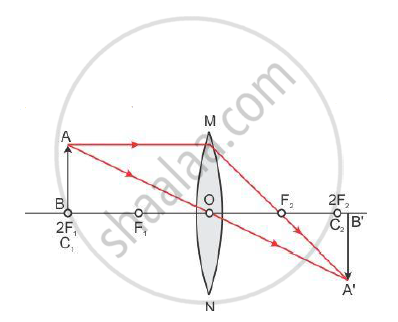Advertisements
Advertisements
प्रश्न
A student is using a convex lens of focal length 10 cm to study the image formation by a convex lens for the various positions of the object. In one of his observations, he may observe that when the object is placed at a distance of 20 cm from the lens, its image is formed at (select the correct option)
(A) 20 cm on the other side of the lens and is of the same size, real and erect.
(B) 40 cm on the other side of the lens and is magnified, real and inverted.
(C) 20 cm on the other side of the lens and is of the same size, real and inverted.
(D) 20 cm on the other side of the lens and is of the same size, virtual and erect.
उत्तर १
(C) 20 cm on the other side of the lens and is of the same size, real and inverted.
Focal length f = 10 cm
The object is placed at 2F (2 ⨯ 10 = 20 cm). Hence the image is also formed at 2F.

| Position of object | Position of image | Size of image | Nature of image |
| At 2F1 | At 2F2 | Same size | Real and inverted |
उत्तर २
Focal length of the lens, f = 10 cm
Object distance, u = −20 cm (negative sign is used due to sign convention)
Using the lens formula:
`1/f=1/v-1/u`
`rArr1/10=1/v-1/(-20)`
`rArr1/v=1/10-1/20`
`rArr1/v=(2-1)/20`
`rArrv=20" cm"`
Hence, the image will be formed on the other side of the lens.
Magnification is given as:
`m=v/u=h_i/h_o`
`h_i/h_o=20/(-20)`
`h_i=-h_o`
Therefore, the image formed by the convex lens will be of same size, real and inverted.
Hence, the correct option is C.
APPEARS IN
संबंधित प्रश्न
A converging lens has focal length of 12 cm. Calculate at what distance the object should be placed from the lens so that it forms an image at 48 cm on the other side of the lens.
At what distance from a concave lens of focal length 20 cm, should a 6 cm tall object be placed so that it forms an image at 15 cm from the lens ? Also determine the size of the image formed.
An object is placed (a) 20 cm, (b) 4 cm, in front of a concave mirror of focal length 12 cm. Find the nature and position of the image formed in each case.
In order to obtain a magnification of −2 (minus 2) with a concave mirror, the object should be placed:
(a) between pole and focus
(b) between focus and centre of curvature
(c) at the centre of curvature
(d) beyond the centre of curvature
If a magnification of, −1 (minus one) is to be obtained by using a converging mirror, then the object has to be placed:
(a) between pole and focus
(b) at the centre of curvature
(c) beyond the centre of curvature
(d) at infinity
Draw a diagram to show how a converging lens held close to the eye acts as a magnifying glass. Why is it usual to choose a lens of short focal length for this purpose rather than one of long focal length?
Explain what is meant by a virtual, magnified image.
To determine focal length of a concave mirror a student obtains the image of a well lit distant object on a screen. To determine the focal length of the given concave mirror he needs to measure the distance between:
(A) mirror and the object
(B) mirror and the screen
(C) screen and the object
(D) screen and the object and also mirror and the screen
An object is placed at a distance of 20 cm in front of a concave lens of focal length 20 cm.
- Find the position of the image, and
- the magnification of the image.
